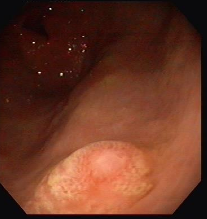7 y.o. FS Portuguese Water Dog with Chronic Vomiting and Diarrhea
History:
-Chronic vomiting, diarrhea, decreased appetite
-Diagnosed with IBD and PLE based on previous endoscopy 3 months prior
-Moderate response to therapy initially, however recurrence of weight loss, lethargy and poor appetite noted frequently.
-Medications: prednisone, metronidazole, famotidine, ondansetron, cyclosporine, mirtazapine
Diagnostics:
CBC: Normal
Chemistry Panel: Elevated liver enzymes, hypoproteinemia and hypoalbuminemia
Previous Diagnostics:
-ACTH Stim: Normal
-Ultrasound: slightly rounded liver with mottling – suspicious for early fibrosis
thickened gastric wall (1cm)
fluid-filled bowel loops and enlarged mesenteric lymph node (3x1cm), ultrasound-guided liver biopsy
-Gastroduodenoscopy:
Stomach: very cobblestoned, edematous appearance. Multiple areas of splotchy red with some erosions – incisura, cardia, fundus all affected.
Duodenum: severely friable and granular. Multiple nodular areas with erosions throughout
-Biopsies
Stomach: Moderate to severe lymphocytic, plasmacytic and neutrophilic gastritis with areas of erosion
Duodenum: Severe, erosive, plasmacytic, lymphocytic, neutrophilic and eosinophilic enteritis with glandular hyperplasia
Moderate cholangiohepatitis with mild multifocal hepatocellular vacuolar change
Problem list:
-History of previously diagnosed IBD and PLE with recurrence of clinical signs
ALICAM Results
-Study Images: 28,797
-Study Time: 13.8h
-Esophageal time: 9 sec (normal)
-Gastric transit time: 6.1h (prolonged)
-SI transit time: 2.1h (normal)
Findings:
-Esophagus: Normal
-Stomach: Prolonged gastric transit time. Many areas with erosions, some of which are large, as well as several hematomas and a few nodular areas. In other areas, the mucosa is irregular, with a cobblestone appearance. At the pyloroduodenal junction, linear areas of erosion/ulceration and bleeding are seen.
-Small intestine: Diffusely irregular duodenal mucosa with a thickened appearance. On some frames, patches of mucosa look eroded with no villi surrounded by thickened/irregular mucosa that looks nodular. There are rare scattered dilated lacteals seen. The appearance of the mucosa remains irregular throughout the SI, but the severity of the changes lessens as the capsule passes distally.
-Colon: the colonic mucosa is partially obscured by yellow mucoid feces, however, areas with erosion and suspect previous hemorrhage can be seen. The mucosa looks irregular in areas and pale round lesions can be seen in two areas.
Recommendations: View PDF Report

Normal Esophagus

Nodular Area in Gastric Mucosa

Irregular Gastric Mucosa

Gastric Erosion Ulcer or Hematoma

Irregular Duodenal Mucosa

Suspect Eroded SI Mucosa Surrounded by Irregular Thickened Mucosa

Irregular SI Mucosa With a Few Dilated Lacteals

Colonic Erosions







 Gastric erosions with irregular mucosa
Gastric erosions with irregular mucosa Beginning of Jejunal Mass
Beginning of Jejunal Mass Ulcerated Jejunal Mass
Ulcerated Jejunal Mass
 Gastric Polyp With Bleeding
Gastric Polyp With Bleeding Gastric Polyp With Bleeding 2
Gastric Polyp With Bleeding 2 Gastric Polyp With Bleeding 3
Gastric Polyp With Bleeding 3 Hematoma
Hematoma
 Gastric Mucosa With Erosion
Gastric Mucosa With Erosion Irregular Duodenal Mucosa
Irregular Duodenal Mucosa Dilated Lacteals in Duodenum
Dilated Lacteals in Duodenum Dilated Lacteals in Jejunum
Dilated Lacteals in Jejunum Irregular and Thickened Jejunal Mucosa
Irregular and Thickened Jejunal Mucosa Colon
Colon Irregular and Erythematous Gastric Mucosa
Irregular and Erythematous Gastric Mucosa Duodenal Nodular Lesion
Duodenal Nodular Lesion Duodenal Nodular Lesion (short arrow) and Erosion (long arrow)
Duodenal Nodular Lesion (short arrow) and Erosion (long arrow) Linear Hemorrhagic Lesions and Irregular Mucosa in Proximal SI
Linear Hemorrhagic Lesions and Irregular Mucosa in Proximal SI SI Linear Hemorrhagic Lesion
SI Linear Hemorrhagic Lesion SI Erosion or Ulcer
SI Erosion or Ulcer Dilated Lacteals
Dilated Lacteals Hemorrhagic Lesion in Proximal Colon
Hemorrhagic Lesion in Proximal Colon Suspect Pedunculated Gastric Mass
Suspect Pedunculated Gastric Mass Suspect Gastric Mass
Suspect Gastric Mass Irregular Duodenal Mucosa
Irregular Duodenal Mucosa Irregular Thickened Jejunal Mucosa
Irregular Thickened Jejunal Mucosa Normal Esophagus
Normal Esophagus Nodular Area in Gastric Mucosa
Nodular Area in Gastric Mucosa Irregular Gastric Mucosa
Irregular Gastric Mucosa Gastric Erosion Ulcer or Hematoma
Gastric Erosion Ulcer or Hematoma Irregular Duodenal Mucosa
Irregular Duodenal Mucosa Suspect Eroded SI Mucosa Surrounded by Irregular Thickened Mucosa
Suspect Eroded SI Mucosa Surrounded by Irregular Thickened Mucosa Irregular SI Mucosa With a Few Dilated Lacteals
Irregular SI Mucosa With a Few Dilated Lacteals Colonic Erosions
Colonic Erosions Irregular Gastric Mucosa
Irregular Gastric Mucosa Gastric Erosions
Gastric Erosions Tapeworms
Tapeworms Irregular Small Intestinal Mucosa
Irregular Small Intestinal Mucosa Gastric Erosions Ulcers
Gastric Erosions Ulcers Gastric Erosions
Gastric Erosions



